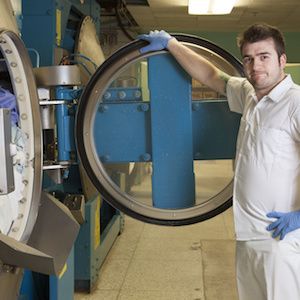C Difficile Spores Remain After Commercial Hospital Laundering
The study found that some C difficile spores can survive the commercial laundry process and may contribute to C difficile outbreaks.

The bedsheets and laundry process in a hospital setting can be a hotspot for C difficile and contribute to outbreaks, according to new findings.
Investigators from De Montfort University in the United Kingdom inoculated C difficile spores onto cotton hospital bedsheets and laundered the sheets through a simulated washer cycle with an industrial bleach detergent. They wanted to quantify the survival of the spores in vitro as well as on bedsheets from patients with C difficile through the commercial laundry process.
The investigators also examined hospital sheets naturally contaminated with C difficile spores and put them through the washer cycle plus a drying and finishing cycle at commercial laundry facilities. These sheets were taken from the beds of patients that were previously diagnosed with C difficile infection and had received care in a designated, isolated C difficile ward.
Two strains of C difficile survived the simulated washer cycle with industrial detergent the investigators observed. Before the sheets went through the laundry, the naturally contaminated sets had an average spore load of 51 cfu per 25cm2, the investigators reported, but after the washing, drying and finishing cycle, the spore load reduced to 33 cfu per 25cm2. This reduction of 40% still allowed bacteria from contaminated sheets to transfer to uncontaminated sheets after they were put through the wash.
According to the investigators, both the simulated and in-situ laundering process “failed the microbiological standards of no pathogenic bacteria remaining.” The team is now working with the Textile Services Association in the UK to continue this research and determine which combinations of laundering can remove C difficile spores from the hospital bedsheets.
“The findings of this study may explain some sporadic outbreaks of C difficile infections in hospitals from unknown sources; however, further research is required in order to establish the true burden of hospital bedsheets in such outbreaks,” lead author Katie Laird, PhD said in a press release. “Future research will assess the parameters required to remove C difficile spores from textiles during the laundry process.”
The team also suspected that these untraceable outbreaks could be linked to the laundry centers, which collect, launder, and redistribute the rented sheet sets to multiple hospitals and care centers, which is the case for the UK’s National Health Service.
“The detergent and additives had the greatest effect in reducing spore burden, whether by removal or in combination with the thermal disinfection,” the study authors wrote. “The surviving spores may contribute to environmental contamination when the sheets are used for bed making in the healthcare environment. Processing infected linen in commercial washer extractor cycles could disseminate low levels of C difficile spores and may be contributing to sporadic outbreaks of C difficile infection.”
The paper, “From ward to washer: The survival of Clostridium difficile spores on hospital bed sheets through a commercial UK NHS healthcare laundry process,” was published in Infection Control & Hospital Epidemiology.